Culture
The Changes in the Shape of the Japanese Sword
Published
7 years agoon
By
Paul Martin
A visitor watches the Japanese sword at the Osaka Museum of History. The museum is holding a special exhibition titled “Sumo and Japanese Swords” in the Special Exhibition Hall on the 6th floor from July 8 (Sat.) to August 28 (Mon.), 2017.

The curved Japanese sword was perfected at the end of the Heian period (974-1185) in the mid 10th century. Since that time the curvature and the geometry of the blade has undergone many changes according to the requirements of the various historical periods. Understanding these changes is an important part of Japanese sword appraisal. This chart illustrates the changes in shape in the different historical eras.
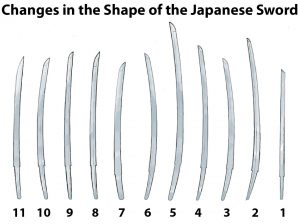
1. Jokoto: Swords of the Ancient Period
Before the emergence of the curved tachi, continental style straight blades called Jokoto were originally brought to Japan from the Asian continent. Later, during the Kofun period (300 AD -538 AD) sword making began to flourish in Japan with makers continuing the straight sword manufacture. They are usually constructed in the hira-zukuri and kiriha-zukuri styles. Many of these straight blades have been excavated from Kofun period tombs, and some were stored in the Shosoin Imperial Repository, Nara.
2. Late Heian to Early Kamakura Periods
This shape represents the earliest curved Japanese swords. Long swords of this era are generally referred to as tachi. It is thought that the shift from straight blades to Japanese swords with curvature happened around the mid-tenth century. They are quite slender blades with the curvature concentrated between the handle and base of the blade. This shape is called koshi-zori. They are shinogi-zukuri (ridgeline) construction, wide at the base of the blade while narrowing acutely towards the small point section (ko-kissaki).
From midway towards the point there is generally very little curvature. The average length of the cutting edge of blades of this period is usually around 75.8 cm-78.8 cm.
3. Mid-Kamakura period
At the zenith of the warrior class’s power during the Kamakura period, the blade’s kasane becomes thick, the mihaba becomes wide and they take on magnificent tachi shape. There is not much difference between the width of the moto-haba and the saki-haba. The blade still has koshi-zori, but the center of the curvature has moved further along the blade. The kissaki has become a compact chu-kissaki (ikubi). The hamon has developed into a flowing gorgeous choji-midare. Also around this time, tanto production appears.
It is thought that the mongol invasions of 1274 and 1281 had an influence on not only the kasane of tachi, but also the manufacture of tanto due to the difficulty in cutting thick leather Mongol armor.
4. Late Kamakura Period
Tachi at the end of the Kamakura period have developed into magnificent blades. There are two types: one is wide throughout its length and the point section is the same as mid- Kamakura period kissaki, but slightly extended. The other is quite slender and similar in appearance to the late Heian, early Kamakura shapes. However, when you look further along the blade, the center of curvature has moved slightly further up the blade.
5. Nanbokucho Period
For reasons that are unclear, many over-sized blades of 90.9cm and longer with large point sections (o-kissaki) were made during the Nanbokucho period. Large size tanto were also commonly produced. Among these were extremely long blades called o-dachi and no-dachi. Blades of this period were rather thin in construction, or have a bo-hi (groove) cut into the shinogi-ji area to lighten the blade to compensate for the extra length. Many tachi from this period were shortened (o-suriage) to regular sword lengths in later periods as they were difficult to wield. Consequently, many extant blades from the Nanbokucho period are unsigned due to being shortened.
6. Early Muromachi Period
Blades of the early part of the Muromachi period are reminiscent in shape to the blades of the early Kamakura period. Compared to the shape of Nanbokucho period blades, the design has completely changed and no longer includes o-kissaki. They are quite narrow and deeply curved with a medium-sized point section. The length of the cutting edge is generally between 72.7 cm and 75.7 cm. They may appear somewhat similar in shape to Kamakura period blades, but on closer inspection they are somewhat saki-zori character.
7. Late Muromachi Period
By the late Muromachi period, fighting methods had changed from cavalry to mass infantry style warfare. Shorter blades, known as uchigatana, with a cutting edge of around 63.6 cm in length that were intended for one-handed use became popular. As opposed to tachi that were worn suspended from the belt, uchigatana were worn thrust through the sash with the cutting edge uppermost. Following the Onin war, conflicts broke out in many places prompting the mass-production of blades (inferior in quality to regular Japanese blades). However, specially ordered blades of excellent quality (chumon-uchi) were also produced at this time. The provinces of Bizen (Okayama prefecture) and Mino (Gifu prefecture) became major places of production. Many blades produced in this period have with strong saki-zori, with either a chu-kissaki or an extended chu-kissaki.
8. Momoyama and Early Edo Periods
Swords produced up to the Keicho era (1596-1614) are classified as Koto (old blades) Blades made during and after the Keicho era are classified as Shinto (new-swords). As peace began to spread throughout Japan during the Momoyama period, many smiths moved gathered in major cities, or castle towns of influential daimyo. Many blades from around this period tend to mirror the shape of that of shortened Nanbokucho blades with a large or extended medium sized point section. They have a cutting edge of around 72.7 cm to 75.8 cm in length. Unlike their shortened earlier counterparts, they retain the maker's signature on the katana-omote and have a thicker kasane than Nanbokucho period blades.
9. Edo Period; Kanbun Era
Swords of the Kanbun period have a noticeably shallow curvature. The saki-haba is relatively narrow when compared to the moto-haba, and they a small to medium-sized point section. They usually have a cutting edge of around 69.7 cm in length. This particular type of construction is usually referred to as Kanbun Shinto and was generally produced around the middle of the Kanbun (1661-1673) and Enpo (1673-1681) eras.
Japan had been at peace for about 50 years, and in that time many Japanese fencing dojo had been established. It is thought that as Japanese swordplay moved into the dojo and became popular, that it affected the shape of the Japanese sword. Up to this point, deeply curved swords had been popular as they were extremely effective for slashing. However, deeply curved swords are also very difficult to fence and thrust with. The smaller confines of practice halls produced the need for a sword that allowed the fencers to stand closer to their opponent to make use of thrusting techniques.
10. Edo Period; Genroku Era
The change in shape of Japanese swords between the Jokyo (1684-1688) and Genroku (1688-1704) eras reflects the transition of shape from Kanbun-shinto blades to the beginning of the Shin-shinto period of sword manufacture. As it was a very peaceful period in Japanese history, rather flamboyant hamon appear. Unlike the previous Kanbun era blades, the curvature once again becomes quite deep. The shape somewhat resembles that of tachi of earlier eras, but they are generally signed on the katana-omote.
11. Edo period; Bakumatsu
Bakumatsu blades are shallow in curvature, have a thick kasane, a wide haba throughout, and an o-kissaki They generally have a cutting edge length of 75.7cm-78.7 cm. In this era, there was a revival movement to recreate blades of older periods. A pioneer of the movement was Suishinshi Masahide. One of Masahide’s noteable students was Taikei Naotane. Minamoto Kiyomaro also led a revival aimed at Soshu-den and Mino-Shizu workmanship.
12. Meiji Period Onwards
In 1876, Haitorei decree was issued banning civilians from wearing swords, resulting in a decline for the need of swords. Blades from this time until present day are referred to as gendaito (modern swords). However, in 1906 the swordsmiths Gassan Sadakazu and Miyamoto Kanenori were designated Tei-shitsu Gigei-in (craftsmen by imperial appointment). Sword making is recognised as a traditional Japanese craft and continues to this day. The sword is obsolete as a weapon in modern warfare, so there are no further needs for modification of the shape. Modern swordsmiths try to recreate the workmanship of eminent smiths or schools of every period mixed with a little bit of their own originality.
Below is a chart of the Japanese Historical Periods to help you.
| Period/Era | Year |
| Heian Period | 794-1185 |
| Kamakura Period | 1185-1333 |
| Nanbokucho Period | 1333-1392 |
| Ouei Era | 1394-1428 |
| Muromachi Period | 1392-1573 |
| Momoyama Period | 1573-1603 |
| Keicho Era | 1596-1615 |
| Edo Period | 1603-1867 |
| Kanbun Era | 1661-1673 |
| Genroku Era | 1688-1704 |
| Bakumatsu | 1853-1867 |
| Meiji Period | 1868-1912 |
Paul Martin is a former British Museum curator, and a secretary of the Nihonto Bunka Shinko Kyokai (NBSK). He is also an appointed Bunka Meister (Master of Culture: Japanese Swords) by the Japonisme Shinko Kai (Honganji).
These are an excerpts from the forthcoming book on National Treasure swords of Japan by Paul Martin.
The answers to the 'Reading Date Inscritions' quiz.
- Heisei Ju Go Nen Haru Kisshobi (An auspicious day in Spring, the 15th Year of Heisei: 2003)
- Heisei Hinoto-I Nen (2007) Year of the Boar.
- Koki Ni Sen Roppyaku San Nen Ju Gatsu Ju Gatsu Kichi Jitsu (An auspicious day in the 2603 rd year of the imperial lineage: 1943).
You may like
-


Immersive Fort Tokyo: Odaiba's New Theme Park Opens
-


Hokusai and the Samurai World
-


The British in Bakumatsu Japan: The Bizen Incident
-


Master Swordmakers of Sakai Give 'Monster Hunter' Kakaru Kumo Nakai's Sword New Life
-


Shin-Gobankaji’s Pledge for the Survival of Japanese Swords
-


Japanese Swords | Join the New Emperor Gotoba Historic Sword Making Project



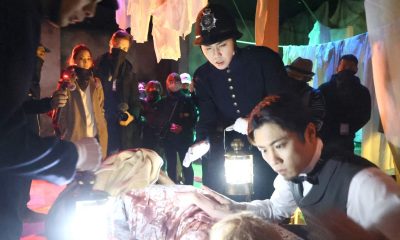

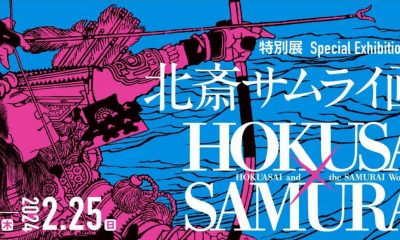

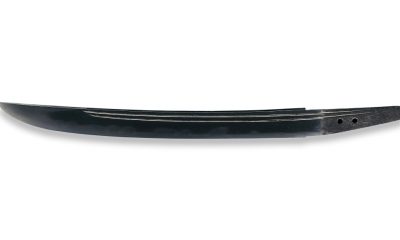

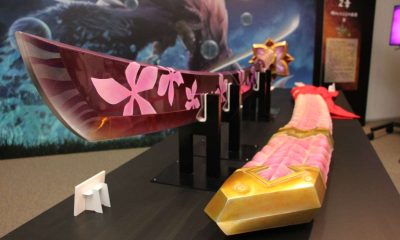



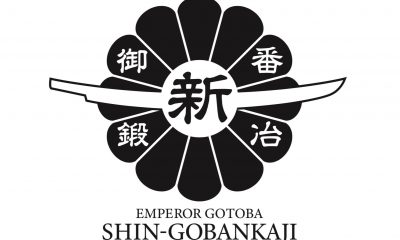



You must be logged in to post a comment Login